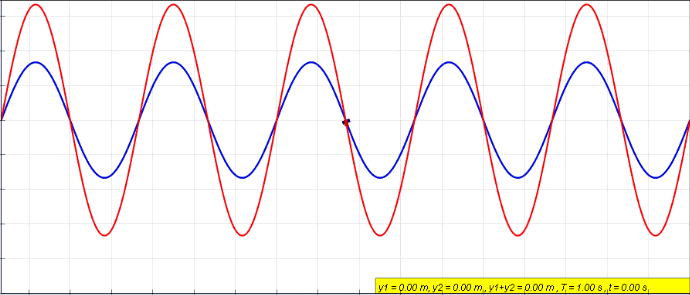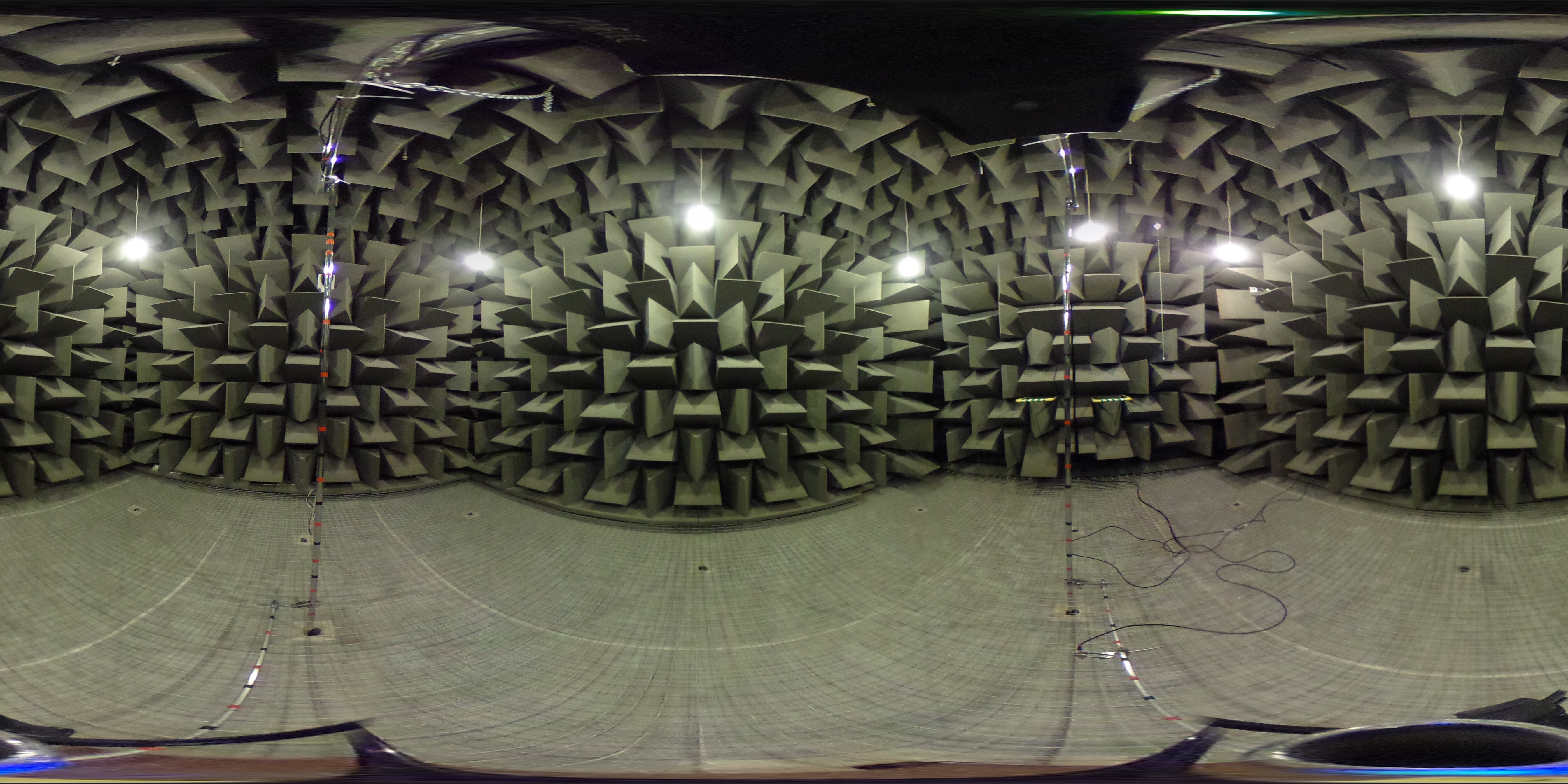|
Reverberation Chamber
A reverberation room or reverberation chamber is a room designed to create reverberation, a diffuse or random incidence sound field (i.e. one with a uniform distribution of acoustic energy and random direction of sound incidence over a short time period). Reverberation chambers tend to be large rooms (the resulting sound field becomes more diffused with increased path length) and have very hard exposed surfaces. The change of impedance (compared to the air) these surfaces present to incident sound is so large that virtually all of the acoustic energy that hits a surface is reflected back into the room. Arranging the room surfaces (including the ceiling) to be non-parallel helps inhibit the formation of standing waves - additional acoustic diffusers are often used to create more reflecting surfaces and further encourage even distribution of any particular sound field. Reverberation chambers are used in acoustics as well as in electrodynamics, such as for measurement microphone ... [...More Info...] [...Related Items...] OR: [Wikipedia] [Google] [Baidu] |
Reverberation
In acoustics, reverberation (commonly shortened to reverb) is a persistence of sound after it is produced. It is often created when a sound is reflection (physics), reflected on surfaces, causing multiple reflections that build up and then decay as the sound is absorbed by the surfaces of objects in the space – which could include furniture, people, and air. This is most noticeable when the sound source stops but the reflections continue, their amplitude decreasing, until zero is reached. Reverberation is frequency dependent: the length of the decay, or reverberation time, receives special consideration in the architectural design of spaces which need to have specific reverberation times to achieve optimum performance for their intended activity. In comparison to a distinct echo, that is detectable at a minimum of 50 to 100 millisecond, ms after the previous sound, reverberation is the occurrence of reflections that arrive in a sequence of less than approximately 50 ms. ... [...More Info...] [...Related Items...] OR: [Wikipedia] [Google] [Baidu] |
Diffusion (acoustics)
Diffusion, in architectural acoustics, is the spreading of sound energy evenly in a given environment. A perfectly diffusive sound space is one in which the reverberation time is the same at any listening position. Most interior spaces are non-diffusive; the reverberation time is considerably different around the room. At low frequencies, they suffer from prominent resonances called room modes. Diffusor Diffusors (or diffusers) are used to treat sound aberrations, such as echoes, in rooms. They are an excellent alternative or complement to sound absorption because they do not remove sound energy, but can be used to effectively reduce distinct echoes and reflections while still leaving a live sounding space. Compared to a reflective surface, which will cause most of the energy to be reflected off at an angle equal to the angle of incidence, a diffusor will cause the sound energy to be radiated in many directions, hence leading to a more diffusive acoustic space. It is also ... [...More Info...] [...Related Items...] OR: [Wikipedia] [Google] [Baidu] |
Acoustic Impedance
Acoustic impedance and specific acoustic impedance are measures of the opposition that a system presents to the acoustic flow resulting from an acoustic pressure applied to the system. The International System of Units, SI unit of acoustic impedance is the pascal-second per cubic metre (symbol Pa·s/m3), or in the MKS system of units, MKS system the rayl per square metre (Rayl/m2), while that of specific acoustic impedance is the pascal-second per metre (Pa·s/m), or in the MKS system the rayl (Rayl). There is a Mechanical–electrical analogies#Impedance analogies, close analogy with electrical impedance, which measures the opposition that a system presents to the electric current resulting from a voltage applied to the system. Mathematical definitions Acoustic impedance For a LTI system theory, linear time-invariant system, the relationship between the acoustic pressure applied to the system and the resulting acoustic volume flow rate through a surface perpendicular to the di ... [...More Info...] [...Related Items...] OR: [Wikipedia] [Google] [Baidu] |
Standing Waves
In physics, a standing wave, also known as a stationary wave, is a wave that oscillates in time but whose peak amplitude profile does not move in space. The peak amplitude of the wave oscillations at any point in space is constant with respect to time, and the oscillations at different points throughout the wave are in phase. The locations at which the absolute value of the amplitude is minimum are called nodes, and the locations where the absolute value of the amplitude is maximum are called antinodes. Standing waves were first described scientifically by Michael Faraday in 1831. Faraday observed standing waves on the surface of a liquid in a vibrating container. Franz Melde coined the term "standing wave" (German: ''stehende Welle'' or ''Stehwelle'') around 1860 and demonstrated the phenomenon in his classic experiment with vibrating strings. This phenomenon can occur because the medium is moving in the direction opposite to the movement of the wave, or it can arise in ... [...More Info...] [...Related Items...] OR: [Wikipedia] [Google] [Baidu] |
Diffusion (acoustics)
Diffusion, in architectural acoustics, is the spreading of sound energy evenly in a given environment. A perfectly diffusive sound space is one in which the reverberation time is the same at any listening position. Most interior spaces are non-diffusive; the reverberation time is considerably different around the room. At low frequencies, they suffer from prominent resonances called room modes. Diffusor Diffusors (or diffusers) are used to treat sound aberrations, such as echoes, in rooms. They are an excellent alternative or complement to sound absorption because they do not remove sound energy, but can be used to effectively reduce distinct echoes and reflections while still leaving a live sounding space. Compared to a reflective surface, which will cause most of the energy to be reflected off at an angle equal to the angle of incidence, a diffusor will cause the sound energy to be radiated in many directions, hence leading to a more diffusive acoustic space. It is also ... [...More Info...] [...Related Items...] OR: [Wikipedia] [Google] [Baidu] |
Measurement Microphone Calibration
In order to take a scientific measurement with a microphone, its precise sensitivity must be known (in volts per pascal). Since this may change over the lifetime of the device, it is necessary to regularly calibrate measurement microphones. This service is offered by some microphone manufacturers and by independent testing laboratories. Microphone calibration by certified laboratories should ultimately be traceable to primary standards a (National) Measurement Institute that is a signatory to International Laboratory Accreditation Cooperation. These could include the National Physical Laboratory in the UK, PTB in Germany, NIST in the USA and the National Measurement Institute, Australia, where the reciprocity calibration (see below) is the internationally recognised means of realising the primary standard. Laboratory standard microphones calibrated using this method are used in-turn to calibrate other microphones using comparison calibration techniques (‘secondary calibrat ... [...More Info...] [...Related Items...] OR: [Wikipedia] [Google] [Baidu] |
Sound Power
Sound power or acoustic power is the rate at which sound energy is emitted, reflected, Acoustic transmission, transmitted or received, per unit time. It is defined as "through a surface, the product of the sound pressure, and the component of the particle velocity, at a point on the surface in the direction Normal (geometry), normal to the surface, Surface integral, integrated over that surface." The International System of Units, SI unit of sound power is the watt (W). It relates to the power of the sound force on a surface enclosing a sound source, in air. For a sound source, unlike sound pressure, sound power is neither room-dependent nor distance-dependent. Sound pressure is a property of the field at a point in space, while sound power is a property of a sound source, equal to the total power emitted by that source in all directions. Sound power passing through an area is sometimes called ''sound flux'' or ''acoustic flux'' through that area. Sound power level ''L''WA Reg ... [...More Info...] [...Related Items...] OR: [Wikipedia] [Google] [Baidu] |
Absorption Coefficient
The linear attenuation coefficient, attenuation coefficient, or narrow-beam attenuation coefficient characterizes how easily a volume of material can be penetrated by a beam of light, sound, particles, or other energy or matter. A coefficient value that is large represents a beam becoming 'attenuated' as it passes through a given medium, while a small value represents that the medium had little effect on loss. The (derived) SI unit of attenuation coefficient is the reciprocal metre (m−1). Extinction coefficient is another term for this quantity, often used in meteorology and climatology. Most commonly, the quantity measures the exponential decay of intensity, that is, the value of downward ''e''-folding distance of the original intensity as the energy of the intensity passes through a unit (''e.g.'' one meter) thickness of material, so that an attenuation coefficient of 1 m−1 means that after passing through 1 metre, the radiation will be reduced by a factor of '' e'', and fo ... [...More Info...] [...Related Items...] OR: [Wikipedia] [Google] [Baidu] |
White Noise
In signal processing, white noise is a random signal having equal intensity at different frequencies, giving it a constant power spectral density. The term is used with this or similar meanings in many scientific and technical disciplines, including physics, acoustical engineering, telecommunications, and statistical forecasting. White noise refers to a statistical model for signals and signal sources, not to any specific signal. White noise draws its name from white light, although light that appears white generally does not have a flat power spectral density over the visible band. In discrete time, white noise is a discrete signal whose samples are regarded as a sequence of serially uncorrelated random variables with zero mean and finite variance; a single realization of white noise is a random shock. In some contexts, it is also required that the samples be independent and have identical probability distribution (in other words independent and identically distribu ... [...More Info...] [...Related Items...] OR: [Wikipedia] [Google] [Baidu] |
Pink Noise
Pink noise, noise, fractional noise or fractal noise is a signal (information theory), signal or process with a frequency spectrum such that the power spectral density (power per frequency interval) is inversely proportional to the frequency of the signal. In pink noise, each Octave (electronics), octave interval (halving or doubling in frequency) carries an equal amount of noise energy. Pink noise sounds like a waterfall. It is often used to tune loudspeaker systems in professional audio. Pink noise is one of the most commonly observed signals in biological systems. The name arises from the pink appearance of visible light with this power spectrum. This is in contrast with white noise which has equal intensity per frequency interval. Definition Within the scientific literature, the term "1/f noise" is sometimes used loosely to refer to any noise with a power spectral density of the form S(f) \propto \frac, where is frequency, and , with exponent usually close to 1. On ... [...More Info...] [...Related Items...] OR: [Wikipedia] [Google] [Baidu] |
Anechoic Chamber
An anechoic chamber (''an-echoic'' meaning "non-reflective" or "without echoes") is a room designed to stop reflection (physics), reflections or Echo (phenomenon), echoes of either sound or electromagnetic waves. They are also often isolated from energy entering from their surroundings. This combination means that a person or detector exclusively hears direct sounds (no reverberation, reflected sounds), in effect simulating being outside in a free field. Anechoic chambers, a term coined by American acoustics expert Leo Beranek, were initially exclusively used to refer to acoustic anechoic chambers. Recently, the term has been extended to other radio frequency (RF) and sonar anechoic chambers, which eliminate reflection and external noise caused by electromagnetic waves. Anechoic chambers range from small compartments the size of household microwave ovens to ones as large as aircraft hangars. The size of the chamber depends on the size of the objects and frequency ranges bei ... [...More Info...] [...Related Items...] OR: [Wikipedia] [Google] [Baidu] |
Echo Chamber
Echo chamber of the Dresden University of Technology Hamilton Mausoleum has a long-lasting unplanned echo An echo chamber is a hollow enclosure used to produce reverberation, usually for recording purposes. A traditional echo chamber is covered in highly acoustically reflective surfaces. By using directional microphones pointed away from the speakers, echo capture is maximized. Some portions of the room can be moved to vary the room's decay time. Nowadays, effects units are more widely used to create such effects, but echo chambers are still used today, such as the famous echo chambers at Capitol Studios. In music, the use of acoustic echo and reverberation effects has taken many forms and dates back many hundreds of years. Sacred music of the Medieval and Renaissance periods relied heavily on the composers' extensive understanding and use of the complex natural reverberation and echoes inside churches and cathedrals. This early acoustical knowledge informed the design of ... [...More Info...] [...Related Items...] OR: [Wikipedia] [Google] [Baidu] |






